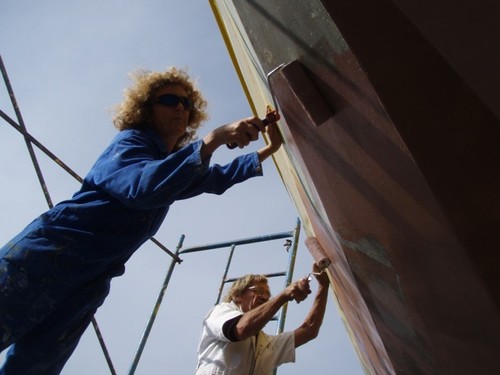The argument for copper antifouling
by Bob Jenner on 6 Aug 2010

Antifouling, the annual job - or is it? SW
Bob Jenner, long time sailor, yacht owner and independent scientist, uses copper anti-fouling on his own yacht. Here he gives us the argument for copper-based anti-fouling:
Much hot air is produced around the subject of us ‘boaties’ polluting the oceans with our anti-foulings and it is probably a good idea to put some facts in the way of the good story, so that a more balanced view may be formed.
Of course, we all need to respect our marine environment, but it should be recognised that good antifouling practice prevents the spread of invasive organisms, such as the invasive sea squirt, Styela clava.
Antifoulings have justifiably had a press since the problems produced by using TBT or tributyl tin in the past. These compounds were extremely toxic and therefore highly effective against marine growth on boats. However, prolonged use in the environment caused many species of mollusc physiology harm including making some of them change sex! These compounds have now been banned for use by small boats, although it is noticeable that big ships are still allowed to use them in some parts of the world.
Copper-based antifouling however, is not in the same league as TBT-for a number of reasons, and, used correctly, has little deleterious effect on marine organisms.
Copper is an essential part of the ocean ecosystem and is required as a trace element for all organisms and in many marine molluscs, is present in their blood, where it replaces the iron we have in our blood in order to carry to carry oxygen. If you want blue-bloods, go see the crustaceans!
Copper in higher concentrations is of course toxic otherwise we wouldn’t use it to prevent growth. Anecdotal evidence suggests however, that from our point of view, copper is not actually toxic enough! Ask any boatie what happens if they miss a small bit of the hull when antifouling. Next haul out that bit is covered in barnacles. This occurs within 10mm of all the rest of the antifouling, several square meters of it. So the antifouling is toxic if the organisms attempt to sit on it or attach to it, but otherwise it doesn’t seem to do much.
Further evidence comes from simple observations in any marina. These waters must contain relatively the highest concentrations of copper around from all the boats in such close proximity. The growth on marina piers however, is spectacular, large fanworms for example, which are filter feeders and particularly susceptible to poisons, do very well. The reports from the cormorants suggest there are also plenty of fish to be had, and local fishermen seem to do quite well.
However, let us be a little more scientific in our approach and look at some actual figures.
The actual natural average copper content of the ocean is 1.9µg/L. [That is microgrammes, meaning one millionth of a gramme. ] This is produced continually from run-off from the land and from volcanic activity.
The lethal dose for most fish according to most researchers is about 1000 times greater than this at 0.1 mg/L. Barnacle larvae have been studied and their lethal dose is higher still at 0.6mg/L. NO wonder the barnacles can settle on my hull so close to the antifouling.
How does that compare to the copper concentrations in marinas?. In one year-long study in the USA in a large marina, the copper concentrations varied from non-detectable to a maximum of 70µg/L, ie about 35 times higher than normal ocean concentration, but would still need to be around 20 times higher than that to affect marine life.
In the open waters, ie when you are sailing around ablative copper leaching would have no effect at all.
Photo above shows a trial patch which was applied as a test to a tug in Fowey Harbour in the UK and left for two years. The rest of the vessel had 'normal' anti-fouling applied.
What happens to the copper in marinas? Does it build up? The answer is yes it does, but combines with organic material in the sediments and is removed from solution, so the active copper content is unlikely to reach harmful levels.
It is interesting to compare the toxicity of copper with the TBTs. The lethal dose of TBT has been found to be 0.000000003 µg/L – putting that in perspective, TBTs are three hundred MILLION times more toxic than copper [ and we’re still letting large ships use it.]I guess we could make a good case for not allowing them into our ports.
In summary, although it would be nice to use a non biocidal solution to antifouling, copper works well and is only toxic to those little greeblies who want to stick to your boat.
Beware of the magic solutions which do not have scientific evidence, such as repelling the invaders with sound- that only works if you play Barry Manilow to teenagers!
If you want to link to this article then please use this URL: www.sail-world.com/73003